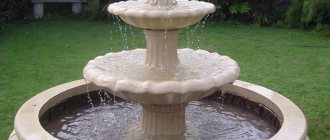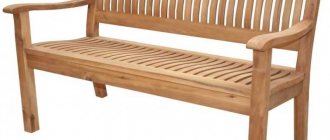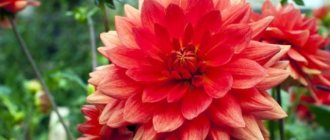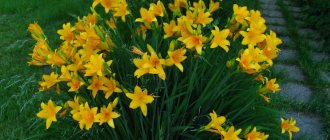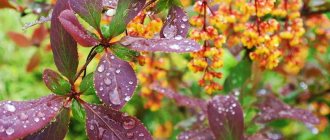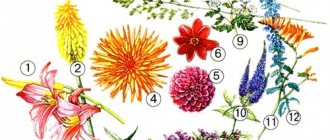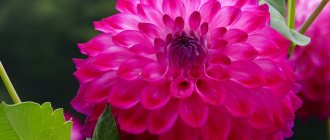Growing dahlias
Growing dahlias at home is not at all difficult - they are completely undemanding flowers. Seedlings or sprouted bulbs are prepared for planting. Seedlings are planted in the ground at the end of spring; favorable conditions can be created using the greenhouse effect, for example, covering them with film. Sprouted tubers are planted earlier.
The plants are thermophilic, so it is better to choose a sunny place for planting. They can also grow in shady areas, but in this case the flowers do not grow so densely, and the buds can be small in size. Ideally, the planting site will have light partial shade, in which case both the flowers and the flowering period will be longer.
They grow without any problems!
- After purchasing, transplant the potted dahlias into a larger container, as they will, of course, grow over the summer. Plants prefer nutrient substrate.
After purchasing, transplant the potted dahlias into a larger container.
- No more than three stems should be left in the bush. If you leave more shoots, the dahlia inflorescences will be smaller.
- Moderate application of fertilizers before mid-August - no later - will contribute not only to good growth of bushes, but also to successful wintering of root tubers (they can be left directly in pots, just do not forget to move the containers to a frost-free room, having previously cut off the stems).
Moderate application of fertilizers until mid-August will contribute not only to good growth of bushes, but also to successful wintering of root tubers Photo: archive of the magazine “Mein schoner Garten”
How to properly care for dahlias
Dahlias need to be watered regularly and abundantly; this will ensure your flower beds grow abundantly and lushly. After planting, it is advisable to water it every day for the first week. Later, you can determine how often they need to be watered depending on weather conditions.
When the soil becomes dry, it is better to water more often; the soil should always be moist, but it is also important not to “flood” the plant, because it is prone to rotting. Young plants can be fed with fertilizers, and they will undoubtedly thank you with dense flowering.
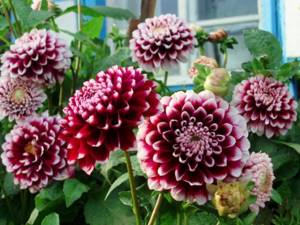
In order for the stems to grow well and not break from the wind, they need to be tied up; for this you can build small pegs to which the plant is loosely tied.
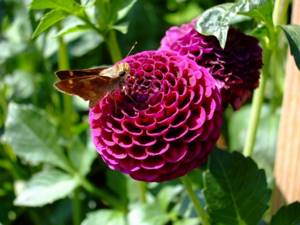
If you prefer perennial types of such flowers, you need to know how to preserve dahlias in winter. During the cold period, plants are also stored in a cool room. When frost occurs, usually in mid-autumn, the stems are cut off, leaving no more than 20 centimeters from the ground.
The bushes are very carefully dug up and cleared of soil. After this, you need to wash and dry the roots. When the plant is completely dry, cut off the remaining stems, leaving just a couple of centimeters. Having completed this operation, the rhizomes are placed in bags filled with peat or sawdust.
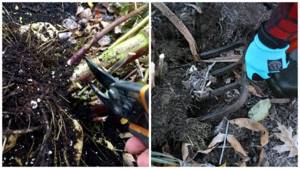
It is important not to let them freeze, the temperature should be slightly above zero degrees, it is good if the room is ventilated. For example, you can store it on a balcony or basement, but check the plant periodically.
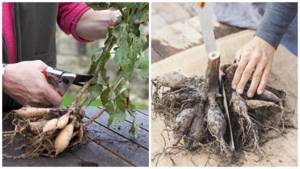
Varieties of annual dahlias
All varieties of annual dahlias are divided into several groups. Belonging to a particular type depends on the height of the plant, the shade and shape of the inflorescences. When choosing hybrids, they are guided by appearance, unpretentiousness, and flowering time.
Bambino (terry mixture)
The Bambino mixture combines early annual dahlias. The plant is dwarf, no more than 25 cm in height. Its terry baskets are large, 8 cm in size. The color of the petals is varied: white, pink, orange, yellow, burgundy. The budding period is long, from July until the onset of frost.
Bambino dahlias look good in flower beds and containers. They are used to design mixborders, paths, and multi-flower beds. The plant responds positively to regular watering.
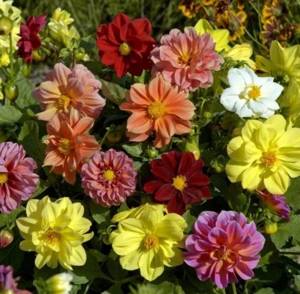
Funny boys
Merry fellows are some of the best annual dahlias. The plant branches well and reaches 50 cm. Its petals are simple and double, of various shades: yellow, pink, purple. The size of the baskets reaches 5 - 8 cm.
The hybrid stands out for its bright and long-lasting flowering. The first buds bloom in June, the period of budding of the crop continues until the autumn cold. To grow it, use the seedling method or plant the seeds directly into the ground. Seedlings easily adapt after transplantation.
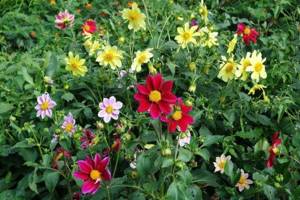
Bright pom-poms
Bright pom-poms are grown as an annual or perennial. The plant is an erect, spreading bush up to 1 m in size. Its inflorescences are compact and dense, up to 8 cm in size. The color of the flowers is white, yellow, pink or orange. The first buds bloom in July. Annual pompom dahlias continue to bloom until the first cold snap.
Advice! Annual dahlias Bright pom-poms are recommended to be grown through seedlings.
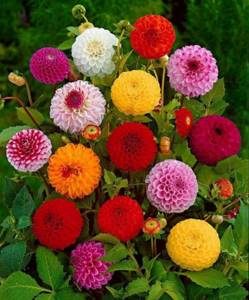
Pompom Mix
The annual Pompon Mix combines several different varieties. They are distinguished by round, dense, spherical inflorescences resembling a pompom. The formation of buds begins in mid-summer and continues until October. The bush reaches a height of 1 m. The hybrid is suitable for decorating a flower bed; it also lasts for a long time when cut.
Collar
Collared dahlias are an interesting variety of annuals. The bushes grow up to 0.5 m in height and have strong and powerful stems, large, dark green leaves. Baskets of unusual shape and color reach 8 cm in diameter. At the edges the petals are open, large, oval in shape. Inside there are erect and slightly curled petals. Flowering is long-lasting, beginning in mid-summer and ending in late autumn.
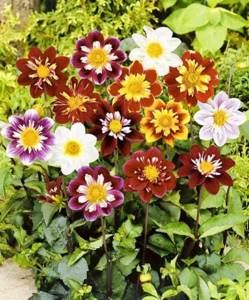
Cactus
The abundantly flowering variety of annual dahlias has compact bushes reaching a height of 0.7 to 1.5 m. The flowers of the crop are numerous, 10 - 15 cm in size. Petals are pointed, twisted, of various colors. 15 - 20 inflorescences are formed on the plant. Its flowering period is extended, from mid-July to late autumn. Cactus dahlias are unpretentious and require moderate watering.
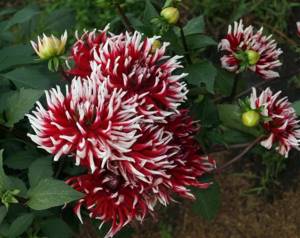
Opera
Annual dahlias Opera are representatives of low-growing species. Their bush is compact, no more than 35 cm high. From July, the plant is covered with bright baskets with a diameter of 7 - 10 cm. Flowering continues until the end of the season. The petals of the flowers are double, their colors are varied: white, orange, yellow, purple. Low-growing annual dahlias of the Opera variety are planted as seedlings or directly in the garden bed.
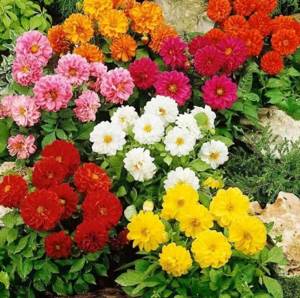
Piccolo
Annual dahlias Piccolo are low-growing, brightly colored hybrids. Plants reach a height of no more than 35 cm. Their baskets are single, simple, up to 9 cm in size. The flowering period begins in July and ends in October. Piccolo is suitable for growing in flowerpots on the street or balcony. By autumn, tubers grow, which can be dug up and left until spring.
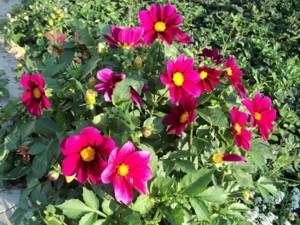
Minion
Annual dahlias Mignon are branched plants 40-50 cm high, which have simple-type inflorescences with a diameter of 8-9 cm, reminiscent of a large chamomile. The middle of the flower is yellow, its petals are oval, yellow, white, purple, pink. The budding process is long, from mid-summer until the last days of the summer season. To grow the annual hybrid Mignon, the seedling method is used.
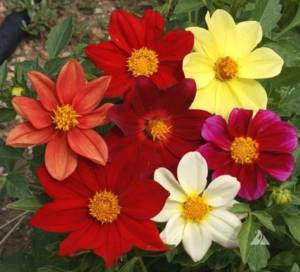
Figaro
Figaro is a representative of double annual dahlias. The bushes of the crop are low-growing, 25-30 cm high, and take up little space on the site. Their flowering is early and long lasting. Semi-double and double flowers with a diameter of 7 - 10 cm have a variety of colors, including delicate pastel and rich shades. Annual Figaro dahlias look most impressive when planted in groups in ridges or borders.
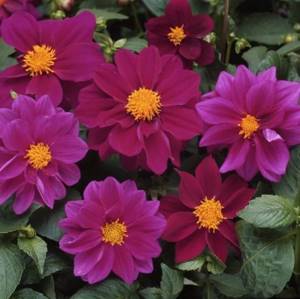
Nurdvix Gloria
The Nurdvix Gloria variety stands out for its bright large flowers. The hybrid was bred in Holland in 1969. An annual up to 1.1 m high with dark green leaves, it has oblong, slightly pointed petals of yellow-orange color. Baskets measuring 15–20 cm appear from June to September. The hybrid is valued for its unpretentiousness.
Important! The annual dahlia Nurdvix Gloria is suitable for cutting and creating large compositions.
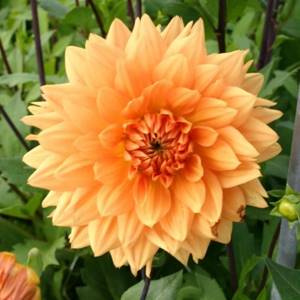
Pharaoh
An unusual variety of annual dahlias with bronze-colored leaves. The plants are low-growing, branched, no more than 50 cm in size. Bright basket-shaped flowers stand out effectively against the background of dark foliage. Their diameter does not exceed 6 cm. Petals are double and semi-double. Each bush produces 10 - 15 flowers until frost at the end of the season. The hybrid is used in group plantings and for cutting.
Photos of flowers of annual dahlias of the Pharaoh variety:
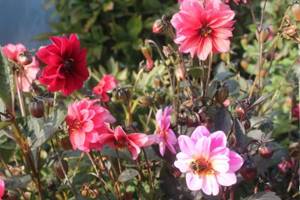
Vasilisa
Vasilisa are compact annual dahlias up to 15 cm high, which have very spectacular large inflorescences in bright colors. The flowering period takes a long period from July to the first frost. The size of the flowers is 6 - 7 cm. Due to early pinching, abundant flowering is achieved. The Vasilis hybrid is planted in open ground or boxes. Containers are left on the balcony, loggia, veranda or gazebo.
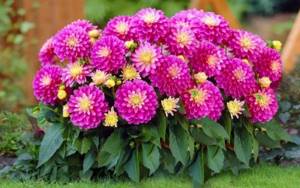
Hoodoshnik
Dahlia Gudoshnik is a tall plant that reaches 1 m. The bush forms large voluminous inflorescences, the diameter of each of which is 15 cm. The flower petals are elongated, arranged in several rows and stand out with a bright two-color color. The bases of the petals are yellow, turning to bright orange towards the tips.
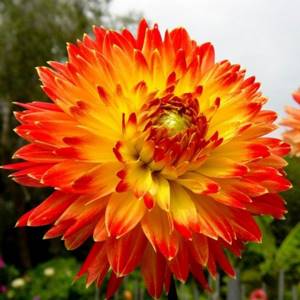
Little Tiger (Tiger Cub)
Dahlia Little Tiger or Tiger Cub is an annual bush up to 0.5 m high. The crop is suitable for decorating multi-flowered flower beds, as well as for growing in containers. Its baskets are large, numerous, 10–15 cm in size, with petals of mixed colors: scarlet at the base and white at the tips. The plant develops best when planted in a sunny area. Little Tiger responds positively to watering and fertilizing with complex fertilizers.
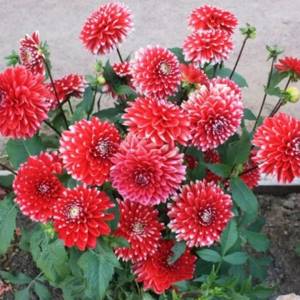
Valentine's card
The annual dahlia Valentine is a spectacular variety that is suitable for growing in flower beds and containers. The dimensions of the bush are no more than 35 cm, so it is used for borders and ridges. The inflorescences of the crop are large, 10 - 12 cm in size. Their color is bright, scarlet, due to which the flowers stand out against the background of dark green foliage. When placed in the sun, the budding process is more active. The petals do not fade in the sun and remain bright even in drought.
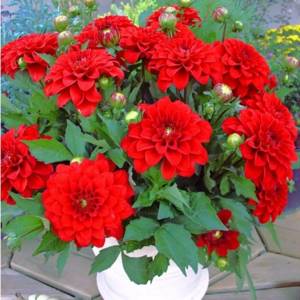
Lark
Dahlias of the Lark variety are cultivated as annual or perennial plants. They are an erect, slightly spreading bush. The dimensions of dahlias do not exceed 60 cm. Their flower stalks are powerful and durable. The petals are double, the size of the baskets is 9 - 12 cm with white, yellow, pink, purple colors. The budding period lasts from mid-summer until the onset of frost. It is recommended to grow the Lark hybrid in seedlings.
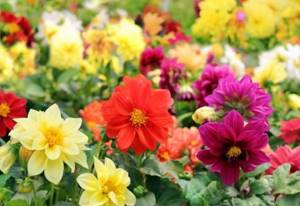
Rainbow
Dahlias of the Rainbow variety are a mixture of medium-sized plants of various colors with a bush size of 50 - 60 cm. The flowers of the crop are large, 15 cm in size, with double petals. The annual Rainbow forms powerful bushes with long peduncles. The process of budding of the crop is long, until late autumn. Rainbow dahlias are light-loving and prefer moist and fertile soils.
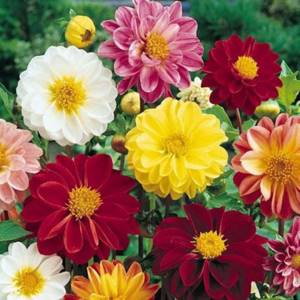
Firework
Annual dahlias Salute are a mixture of hybrids with unusual petal colors. The bushes grow up to 45 cm and are compact in size. Baskets are numerous, in contrasting colors. The main background is white, red or purple, with stripes on it. Flowering lasts for 2 months.
Advice! When planting in the ground, leave 35-40 cm between annual dahlias. This way the plants will receive the necessary space for development and good lighting.
Bride
The annual variety Bride produces snow-white, dense flowers. The dimensions of the bush do not exceed 60 - 90 cm. The leaves of the plant are numerous, dark green. Large inflorescences with a diameter of 10 - 15 cm. White flowers stand out effectively against a green background. Hybrid Bride is suitable for growing in garden beds and containers.
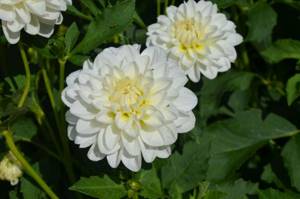
Pruning is an important part of care
Your flowerbed will bloom earlier if you promptly remove the side shoots that grow near the leaves. You can leave only the strongest shoots, then the buds will grow larger and bloom longer.
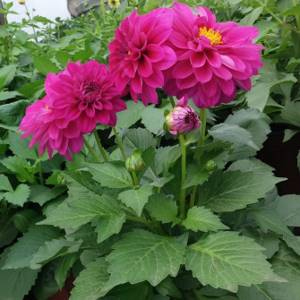
Having chosen a dahlia variety with a tall trunk, you also need to cut off the lower leaves so that air can circulate throughout the plant. Low-growing species do not need to be trimmed or shaped. Flowers that begin to fade should also be cut off so that they do not take a lot of energy from the plant.
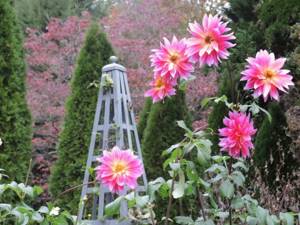
Dahlia flowers: planting and care in open ground
Dahlias are considered undemanding plants; they thrive in both sunny and shaded areas. But in the second case, the color of the petals will not be so bright. The optimal solution is to place dahlias in light partial shade. An important condition is the level of soil moisture; in waterlogged areas the plant will not feel well, and the tubers may begin to rot. Therefore, if you want to grow dahlias in such areas, do not forget to arrange drainage from expanded clay or brick.
How to plant dahlias in the garden.
Planting dahlias with tubers is carried out in the spring, sometimes planting in early summer is allowed, because it is important that the soil warms up well.
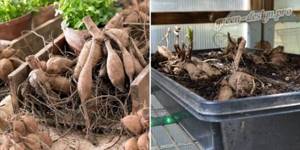
Also, tubers are often pre-germinated, which speeds up the rooting process in the garden.
To plant bushes, dig holes based on the size of the tubers. Also, put a little manure or compost in each hole, after which the rhizome is placed there and covered with soil. To do this, they are placed on polyethylene with a layer of sawdust or light soil. Plantings need to be irrigated systematically to keep them moist. This kind of mini-greenhouse will allow the plants to wake up and flowering in the garden will begin a few weeks earlier.
Also, do not forget to tie up the crops during flowering, since the stems can easily break from the weight of the flowers or gusts of wind. To do this, equip supports. Watering the bushes is carried out as the soil dries. In parallel with moistening dahlias, you can feed them with organic matter (manure or compost), as well as nitrogen substances and wood ash.
Pest Control
Sometimes plant stems can be damaged by slugs. To control pests you will need to use a decoction of celandine or wormwood. The bushes are sprayed with the prepared product once a week. If the folk remedy does not help, then you will have to resort to insecticides.
Preparing dahlias for winter
Tubers must be dug up before frost arrives. The shoots are trimmed, leaving 5-10 cm in height. In order not to damage the rhizomes, you need to dig them up from several sides, retreating 20-30 cm from the stem. Then the soil is removed from the roots, and the tubers are laid out to dry. When they are dry, place them in a box and cover them with ash or a layer of peat.
Another way to preserve dahlia tubers indoors
Planting material must be stored at an air temperature of 3 to 5°C.
Plant propagation
You can use three propagation methods - dividing tubers, seeds and cuttings. The first method is that the tubers are divided into several parts, each of them is germinated, then distributed into different holes.
This video shows the process of propagating dahlia flowers by seeds.
Cuttings involve cutting off an element under a leaf node and planting it in moistened sand. For quick rooting, cuttings are treated with a means for rapid root growth.
Versatility of colors
Few flowers can boast such a variety of varieties and species as dahlias. There are officially more than forty species of dahlias. Let us note some of the popular varieties:
- simple. Usually a single row of petals ranges from pink to orange and reddish hues.
- anemone-shaped - may have one or more rows of tubular-shaped petals;
- collared, so named because of their petals, which look like small cream-colored collars;
- peony dahlias.
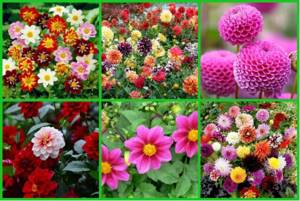
The name itself makes it clear that the shape resembles peony flowers, pink tones;
- decorative types of these flowers have double inflorescences. They can be both large and small;
- spherical - already have a more distinct rounded shape with many flattened branches;
- pompon dahlias resemble the previous species. The edges of the petals are rounded;
- cactus and semi-cactus dahlias acquire curled, sharp tips. At the same time, the color spectrum here is much wider;
- nymphea - have a delicate pink or red color, a little reminiscent of lilies.
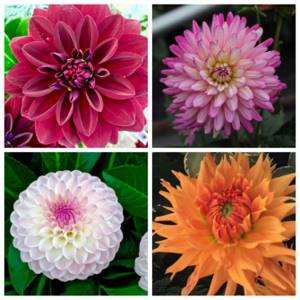
A large number of photos of dahlias will help you understand the external differences in more detail.
Varieties of dahlias
There are more than 40 varieties of the plant, but the most popular are:
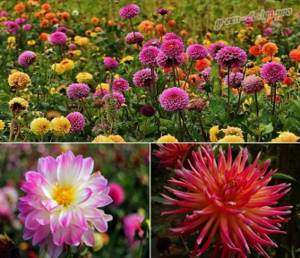
- Needle-shaped. They have thin petals twisted into a tube, they resemble thin needles, hence the name.
- Globular. They are distinguished by lush round inflorescences. The petals are large, fleshy. The inflorescences are loose and soft.
- Anemone-like. The petals are short, graceful tubes, and have a flat shape around the perimeter.
The benefits of flowers
Dahlias are valued not only for their unusual beauty, but also for their medicinal abilities. Nature has endowed them with substances that can help rid the body of toxins and cholesterol.
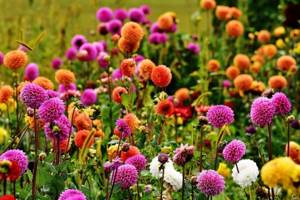
For diseases of the cardiovascular system and pancreas, it is useful to use decoctions of small buds of these flowers. Note that not only dahlia buds are used for medicinal purposes. A tincture of leaves and rhizomes will be a good preventive measure against diabetes.
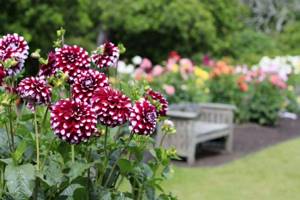
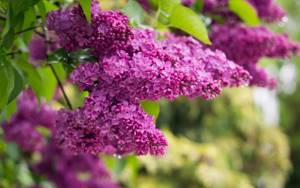
Description of the best varieties of lilac with photos and names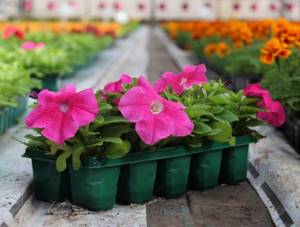
How to grow excellent petunia seedlings
- How to properly water an orchid in a pot: the benefits of automatic watering for the plant
In addition to its delicate aroma and medicinal use, the bright flower can delight the fair sex as a cosmetic product. A mixture of bud powder with honey and egg will give your hair shine and strength.
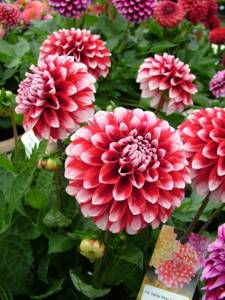
The face will glow with health if you apply fresh leaves to problem areas of the skin. The same method will help with cuts and also get rid of acne.
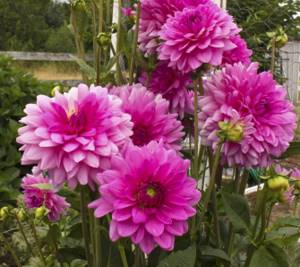
Pruning dahlias
In order for dahlias to delight with bright and large flowers as often as possible, it is necessary to do pinching - cutting off excess stems. It is recommended to do this constantly, and to remove even more shoots during the flowering period.
Cutting the shoots that emerge from the axils of young leaves is done with pruning shears or a blade if they are very thin. At the end of the procedure, the cut areas should be sprinkled with charcoal to prevent pathogenic bacteria from developing there. It is strictly forbidden to perform pinching in the open sun or in humid weather. In the first case, this will lead to drying out of the stems, and in the second, it can even provoke rapid rotting and death of the plant.
Edible dahlias
Surprisingly, dahlias are also used in cooking. Leaves, both fresh and dry, can be added to salads or small snacks. If you're on a diet, the good news is that flowers have virtually no calories, but this will not ruin their taste.
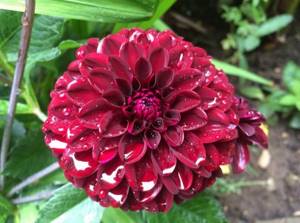
Even the ancient Mayans noted the root crops of this plant. The tubers make a wonderful drink, for example, if you add honey. The taste of fried root vegetables is somewhat reminiscent of potatoes or carrots.
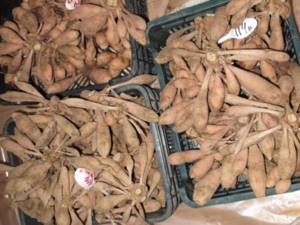
If such an experiment is a novelty for you, dahlia leaves will undoubtedly appeal to horned domestic animals or, for example, rabbits will happily gnaw them.
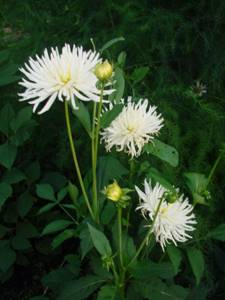

Tulips for March 8: varieties, planting dates and forcing methods- Brugmansia: planting, growing, care and propagation in open ground. 75 photos of a beautiful flower
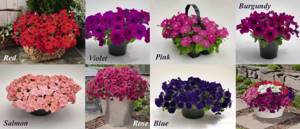
Petunia - growing from seeds. Instructions for care, propagation and planting at home (110 photos)
Small, large, low or tall dahlias can undoubtedly be called the main decoration of the site. By following simple recommendations, your garden will delight you and your friends with many colors.
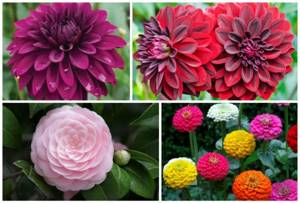
Description of dahlias
Flowers Dahlia or dahlia (Dahlia) belongs to the herbaceous genus of garden crops that belong to the Asteraceae (Asteraceae) family. The plant is tuberous, perennial, and has bright and beautiful flowers.
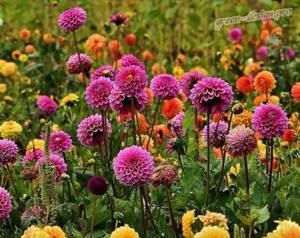
The color of the petals can be varied, from red, burgundy to yellow, white, mixed.
The leaves are simple, arranged in pairs. The height of the stems can reach up to 250 cm. The roots-tubers of dahlias are fleshy and thickened. In our conditions, they are dug up for the winter.
After flowering, an achene is formed - a kind of fruit, 1 gram of which contains about 14 seed material.
Seed growing method
Annual varieties of dalia, for example, double Rigoletto, non-double Coltness Hybrids, Redskin with bronze leaves, are grown by seed, perennials - by planting tubers in the spring. The choice of method depends on the varietal characteristics, the availability of planting material, the climate of the area, and the purposes of planting (site decoration, for cutting).
When sown directly into the ground in the second decade of May, flowering will occur in August; to obtain early flowering, the seeds are germinated. Germination begins in the first ten days of April.
Germination and planting:
- pour calcined sand into a low plastic container and moisten it;
- spread the seeds evenly, sprinkle with a thin layer of dry sand, lightly moisten with a spray bottle;
- cover with a transparent lid and place in a warm (25-27 ° C) place for about 10 days;
- the lid is regularly opened to remove condensation, and the sand is moistened if necessary;
- grown seedlings dive into plastic cups (300-500 ml) filled with loose ready-made soil for flower seedlings or a self-prepared substrate (1 part sand and peat + 2 parts leaf soil);
- the soil is spilled with a hot (70 ° C) dark pink solution of manganese three days before planting;
- seedlings are watered when the top layer of soil dries;
- on the ridge, the flowerbed is replanted in the second decade of May.
Related article:
Reproduction and care of white hydrangea
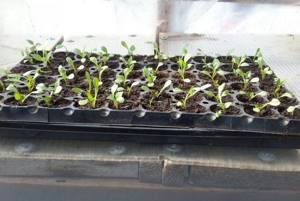
Characteristics and Features
Europeans learned about the new plant in the 16th century during expeditions to South America, where in Mexico they discovered unusually beautiful flowers growing both in the wild and near the homes of local residents. In the 18th century, they appeared in European gardens, where they were grown as a rare ornamental plant. They were brought to Russia at the end of the 19th and beginning of the 20th centuries and are now used for decorative purposes and for cutting.
The flower owes its scientific name – “dahlia” – to A. Dahl (a student of C. Linnaeus), who described it. The name “dahlia”, which is used in Russia and neighboring states, was received by the plant in honor of I.G. Georgi is a professor of botany. Dalia (dahlia), thanks to his efforts, became accessible to all segments of the population.
Related article:
Colchicum autumn flower
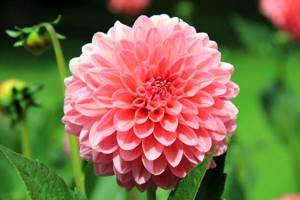
The Dahlia genus, part of the Asteraceae family, is a herbaceous perennial with a tuberous root system. The tubers contain a supply of nutrients necessary for the initial growth of growth buds located on the root collar. In temperate climates, tubers are dug up for the winter and stored cool until spring.
The above-ground part consists of a hollow, thick, fleshy stem that dies off at the end of the growing season. Its height depends on the variety and reaches 25-250 cm. The leaf with uneven blades is large (10-40 cm in length), pinnately dissected, rarely whole, in various shades of green and purple.
This is interesting: The most beautiful varieties of dahlias
The basket inflorescence is formed by marginal ligulate and tubular central (middle) flowers. The color, appearance and shape of the reed flowers are different, the middle ones are yellow, brownish-red, and orange. Up to 60 inflorescences can form on one bush. About 140 seeds ripen in the achene fruit and remain viable for three years. The flowering period lasts from mid-summer until frost.
Related article:
Symphiandra: types, cultivation
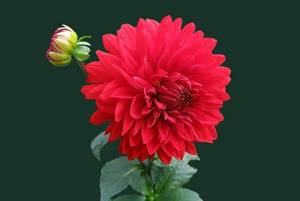
How to germinate dahlias (video)
The flower is popular in landscape design and is used for cutting. Small forms are indispensable in formal flower beds, mixborders and background groups. Particularly popular among domestic amateur flower growers is the charming early-flowering mixture “Figaro Mars” with its compact bush shape and large double and semi-double flowers that can decorate any flower garden in the open ground.
Autumn care for dahlias and preparing tubers for wintering
Autumn for me means dahlias. Mine begin to bloom as early as June, and all summer the neighbors peek at me over the fence, reminding them that I promised them a few tubers or seeds by the fall. In September, a tart note appears in the aroma of these flowers, hinting at the approaching cold. This means it’s time to start preparing the plants for the long, cold winter. In this article I will share my secrets of caring for dahlias in the fall and preparing them for winter storage.
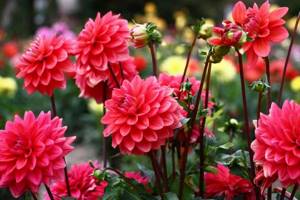
Autumn care for dahlias and preparing tubers for wintering.

